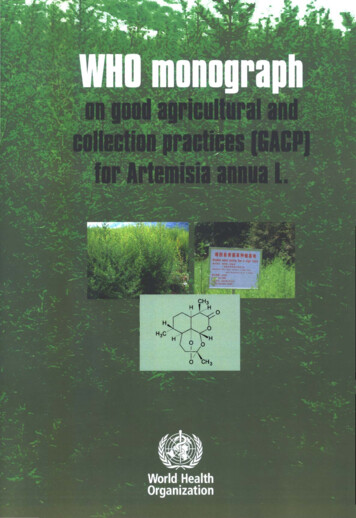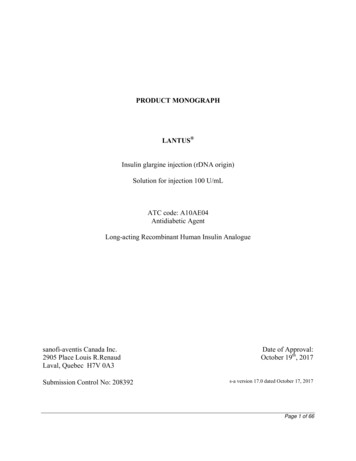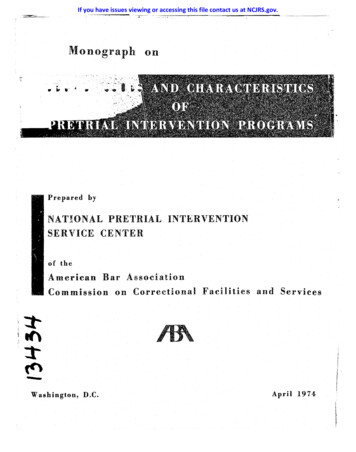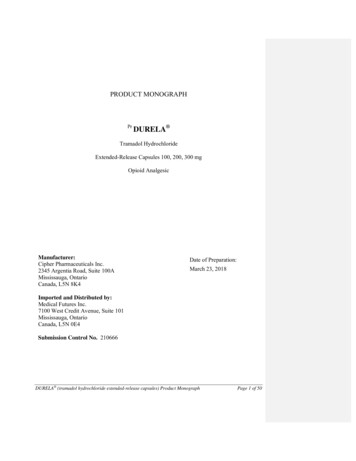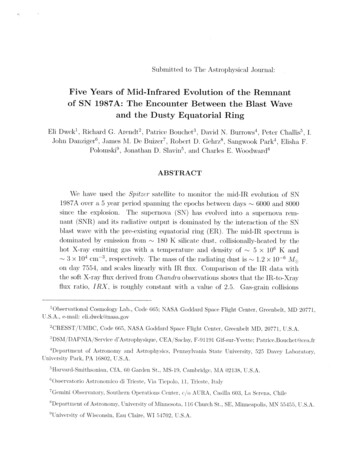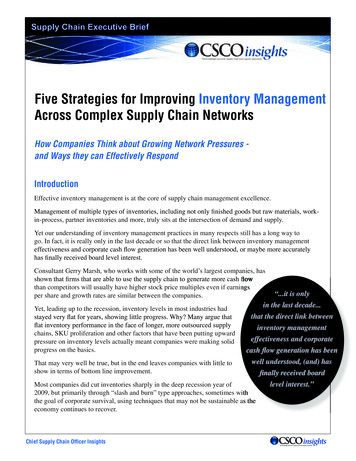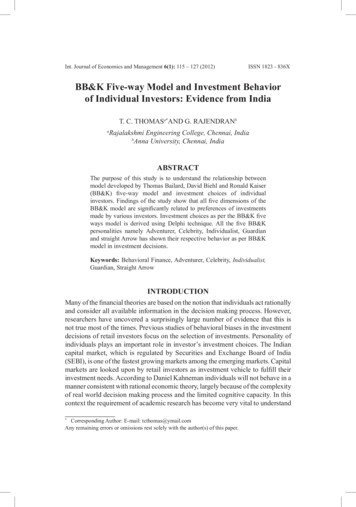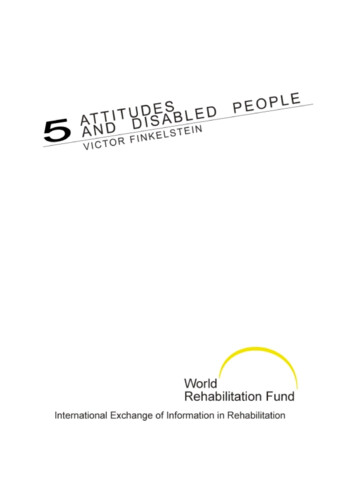
Transcription
MONOGRAPH NUMBER FIVEAttitudes and Disabled People:Issues for DiscussionVictor Finkelstein, B.A. (Hons), M.A., P.G.C.E., A.B.Ps.S.Lecturer, Post-Experience Courses Unit,The Open University, Milton Keynes, MK7 6AA, Great BritainInternational Exchange of Information in RehabilitationWorld Rehabilitation Fund, Inc.400 East 34th StreetNew York, New York, 10016
Copyright 1980 World Rehabilitation Fund, Inc. Portions of this publication may bereprinted provided permission to do so is obtained in writing from the WorldRehabilitation Fund, Inc. or from the National Institute of Handicapped Research,Office of Human Development, U.S. Department of Health, Education and Welfarewith whose support the project resulting in this publication was conducted.This monograph series was supported in part by the World Rehabilitation Fund, Inc.under Grant #22P-59037/2-01 from the National Institute of Handicapped Research,U.S. Department of Health, Education and Welfare, Washington, D.C. 20201,United States of America.Reprinted by R.A.D.A.R.25 Mortimer StreetLondon W1N 8ABLamport Gilbert Printers Ltd., Reading
PREFACEABOUT THE INTERNATIONAL EXCHANGE OF INFORMATION INREHABILITATION:In order to put this particular piece of writing into perspective, it is important first tocite the legislation to which the International Exchange of Information in Rehabilitation is responsive:REHABILITATION ACT 1973REHABILITATION, COMPREHENSIVE SERVICES, ANDDEVELOPMENTAL DISABILITIES AMENDMENTS OF 1978RESEARCHSection 202(b)5.Conduct of a program for international rehabilitation research, demonstration,and training for the purpose of developing new knowledge and methods in the rehabilitation of handicapped individuals in the United States, cooperating with andassisting in developing and sharing information found useful in other nations in therehabilitation of handicapped individuals, and initiating a program to exchangeexperts and technical assistance in the field of rehabilitation of handicapped individuals with other nations as a means of increasing the levels of skill of rehabilitationpersonnel.To develop this project and implement the law, a series of considerations wereaddressed by the World Rehabilitation Fund. These considerations took into accountthe following: (1) What are the knowledge and method gaps which would satisfy theinformation needs of the rehabilitation system in the United States? (2) In what formcould information developed in other countries be presented? (3) What are the keytransmission points/target audiences for sharing knowledge in the U.S. rehabilitationcommunity? (4) What foreign resources can be identified to develop and share theinformation? (5) How can one evaluate the effectiveness of the program? (6) Whatsteps could be taken to build on utilization of the materials?The International Exchange of Information in Rehabilitation project is designedto facilitate the sharing of rehabilitation information transnationally by commissioninga series of brief monographs by foreign experts on topics which reflect knowledgegaps in rehabilitation in the United States. The design for the project emerged as theresult of determining that a need existed for information to be made availabletransnationally to targeted groups of U.S. rehabilitation personnel at a length whichwould make information accessible and readable while at the same time satisfyingcuriosity about the particular subject.In May 1 978 a Transnational Conference was held by World RehabilitationFund to which four foreign rehabilitation experts (generalists) and eight U.S. “centersof influence” in rehabilitation were invited, including representatives from the StateVocational Rehabilitation system, the American Coalition of Citizens WithDisabilities, a Research and Training Center, the National Rehabilitation Association,Rehabilitation Counselor Education, and the Rehabilitation Services Administration(now the National Institute of Handicapped Research), as well as the WorldRehabilitation Fund’s Officers and Consultants.
The primary goals (as they related to the International Exchange of Information) of this meeting of the Advisory Council were to:1.Decide on the knowledge gaps in rehabilitation in the U.S. to which thisproject would be responsive.2.Obtain nominations from the foreign advisors present for potential monograph authors (individuals from their countries who could expertly addressthe topics).3.Determine the target audiences for the monographs.4.Develop the evaluation component of the program.Final selection of five monograph authors for the Project Year ’78-79 was madeby World Rehabilitation Fund staff and consultants and these authors were thencommissioned to prepare monographs over a six to eight month period of time. Aninitial first draft was submitted for U.S. and foreign peer review. The resulting reviewswere then returned to the author who had the opportunity to make use of anycomments, suggestions or criticisms in the preparation of the final draft.Also, where utilization conferences were held (the project design called for theholding of conferences to promote research utilization and knowledge transfer onthree of the five monographs), authors made use of feedback from conferenceparticipants to make final alterations in their material,In some cases, the individual monograph will stand alone on its merits. In othercases, we are including United States commentary relating to the monograph itselfand to the particular topic. This commentary emerges out of the peer review andparticipation research utilization conferences.The World Rehabilitation Fund, Inc. is indeed pleased to be able to present thisMonograph Series to the United States rehabilitation community with the hope thatthe monographs will help to promote the continuing exchange of information transnationally toward the ultimate goal of enhancing the quality of life for the disabled inthe United States and all over the world.It must be said that the World Rehabilitation Fund, Inc. took the philosophicalposition of allowing complete freedom in the preparation of these monographs.Therefore, the views expressed (and the knowledge and information conveyed) arethose of the author, the sources the author has selected, and the national socioeconomic context from which the material emerges.Howard A. Rusk, PresidentWorld Rehabilitation Fund, Inc.
ACKNOWLEDGEMENTSWe would like to be able to acknowledge all of those individuals who have shown aninterest in the preparation of this monograph. However, there are indeed too many tomention here. We wish to thank particularly those individuals who shared theirexpertise at a research utilization conference held around this paper in itsunpublished form, those who volunteered helpful peer review and those who havewritten commentaries to accompany Attitudes and Disabled People: Issues forDiscussion in its published form: Tamara Dembo, Susan Daniels, Nancy Kerr, LeeMeyerson, Jerome Siller, Joseph Stubbins and Beatrice Wright. (For a list of allconference participants whose involvement with the monographs we are deeplygrateful for, see Appendix A.)Finally, we wish to express our appreciation to Mr. George Engstrom, NIHR projectofficer, for his help and guidance throughout.
SUMMARYThe central thesis of this monograph is that "disability" is an oppressive socialrelationship. Its focus is attitudes towards "disability". Prevalent attitudes, however,are only uncovered as a result of research or social analysis. It is argued that thosewho carry out research or social analysis of necessity participate in the "disablingsocial relationship". What we know about attitudes, therefore, cannot be separatedfrom the conditions in which they are uncovered. The monograph aims to encourageservice deliverers to adopt a more critical attitude towards their own participation inthe disability relationship. It also seeks to encourage a more critical attitude towardsviews which treat the subject matter in isolation from the definite historical socialrelationship in which such attitudes are uncovered.
TABLE OF CONTENTSPageSummary1INTRODUCTION.11.1 The paradox of disability .11.2 The objective.12DISABILITY: UNDERSTANDING A PARADOX.32.1 Defining the paradox.32.2 Attitudes can only be uncovered by participatingin the disability paradox .52.3 Creating and eliminating the disability.633.13.23.3THE MISFORTUNE OF ADJUSTMENT .8The problem.9Normative assumptions.11Phase two choices .134DISABLING ATTITUDES .154.1 Attitudes and behaviour .154.2 Simulated disability and attitudinal research .165STIGMA: Spoiling the notes on the managementof prejudice.1966.16.26.3PHYSICAL DISABILITY: A materialist approach .22Redefining disability .22Disability and human history .25Attitudes: a final word.26AppendicesA.B.U.S. COMMENTARIES.29RESEARCH UTILIZATION CONFERENCE .59
1.INTRODUCTION1.1 THE PARADOX OF DISABILITYSince the turn of this century the number of workers, professional and lay, inindustrial societies who work in the field of disability has increased enormously.Almost every aspect of the life of a person who is disabled has its counterpart in a“profession” or voluntary organisation. Potential and real control over the life of adisabled individual is a modern fact. This has resulted in the attitude that thedisabled individual is obviously particularly dependent upon others for help. Thegrowth of professional “expertise” in the field has also meant that these helpers havehad an almost absolute monopoly in defining and articulating the problems ofdisability to the public at large. One result of this has been the appearance ofdisabled people as passive, the objects of research and help. The numericalincrease in helpers has also necessitated the need for a team approach to thedisabled individual. While the helpers have grouped together, gaining confidence intheir roles from their colleagues, they have done so to help the disabled individualDisability, therefore, has been seen as a personal misfortune.The increasing help has also facilitated greater numbers of disabled peoplefunctioning independently in the community. Disabled spokesmen andspokeswomen have become increasingly active in articulating their own perceptionsof their situation. Since the Second World War there has been a rapid growth in thenumbers and size of organisations of disabled people and increasingly, particularlyduring the past decade, a growing group identity.The most immediate impression of disability, therefore, is paradoxical. On the onehand there is the appearance that disability implies a personal tragedy, passivity anddependency. On the other hand disability can be seen as a form of groupdiscrimination, involving constant struggles and independent action. The paradox ofdisability confounds any attempt to discover uniform attitudes towards disabledpeople. It is also a challenge to helpers to face squarely their role in a conflictualsocial relationship.“Disability”, it should be noted, is given a particular definition in this work and muchof the discussion is concerned with its real nature. It is defined in terms of the specialform of discrimination, or social oppression, that is faced by people who are in someway physically impaired. In a sense, the whole monograph can be viewed asdefining disability and as attempting to raise some of the issues involved in changingattitudes towards this paradox, called disability.The monograph is addressed principally to those workers entering, or alreadyworking in, the rehabilitation and welfare services (whether professional, lay, fulltime, part-time, disabled or non-disabled workers). It is also hoped that themonograph will be of interest to the “consumers” of help, disabled people, as well astheir friends and relatives.1.2 THE OBJECTIVESThe monograph makes no attempt to review the literature on the findings ofattitudinal research in “the field of disability”. Nor is there any attempt at analysingthe reliability and validity of the diverse methodologies employed both in researchingand effecting changes in attitudes towards disabled people.1
Two objectives are set.a)The monograph should lead to a more critical stance towards the situation andmethods used in establishing what attitudes towards disability are prevalent insociety.b)The monograph itself should make some contribution regarding modifyingattitudes toward disabled people and the situations they face.2
2.DISABILITY: UNDERSTANDING A PARADOX2.1 DEFINING THE PARADOXThe increasing number of workers catering to the needs of disabled people hasbeen paralleled by increasing State intervention in the provision of medical andwelfare services. From its inception, the National Health Service in Great Britain hasbeen involved in the provision of certain services, aids and equipment free of chargeto disabled patients. The medical profession retained a large responsibility for theprovision of these services and each individual prescribing doctor based his decisionupon his accumulated “clinical experience”.The Social Services’ involvement in the provision of services, aids and equipment todisabled clients, however, posed somewhat different problems for the personnelinvolved in decision-making. Firstly, the Social Services are engaged in providingservices (e.g. “meals on wheels” to elderly or disabled citizens living in thecommunity), aids (e.g. a bath seat) and equipment or adaptations (e.g. building aramp in place of stairs), which have few traditions to draw upon. This ruled out theclinical tradition of the medical profession. Secondly, they have been concernedwith the determination of eligibility for financial benefits and for administering thesefunds. In Great Britain it became of paramount importance to establish clearerdefinitions so as to determine who was entitled to services and certain benefits orprovisions.Following the proliferation of research and papers on suitable definitions, one set ofdefinitions has received some currency in Great Britain:Impairment has been defined as “lacking part or all of a limb, or having adefective limb, organ or mechanism of the body”. Handicap is “thedisadvantage or restriction of activity caused by disability”. (1)and the following is offered as an example of how these terms may be used:A man had a leg amputated. Therefore he is impaired, and since he wouldhave a reduction of his locomotive ability, he is disabled. If, however, he has asatisfactory prosthesis, a sedentary job, a car adjusted to hand controls andleisure activities which are not too active, he might well not be restricted inactivity and therefore not handicapped. (1)If we are to understand the significance of certain attitudes, we must be preciseabout to which aspects of disability they refer. We need to remember, too, that allwe know about social attitudes comes from research in which researchersthemselves form part of the paradox. Those involved in helping disabled people willnot be able to evaluate the significance of what they are taught unless they areequipped to respond to the conditions under which these attitudes come to light.At this point it will be helpful to look at an example of the way in which we definedisability, or handicap, affects our interpretation of so-called attitudes towardsdisabled people. In their paper Kleck, et al (2) describe two complementaryexperiments. These involved a confederate of the experimenter engaged in adeliberate deception which entailed the enactment of “handicapped” or “nonhandicapped” roles in an interviewing situation with the duped subjects. Theconfederate pretended to be a person with a leg amputation (sitting in a speciallydesigned wheelchair) and interviewed subjects on a defined topic. The sameconfederate also interviewed subjects as a (normal) non-handicapped interviewer.3
The details of the experiments and results are not of interest here. We are onlyconcerned with the situation that was manufactured.What is clear, if one accepts the definitions of impairment, disability and handicappresented earlier, is that the confederate is not “handicapped” in either role. Since ahandicapping situation did not exist in the two described experiments (i.e. having aleg amputation impairment does not in itself relate to a disability which might causethe person to be handicapped as an interviewer), the findings cannot have relevancefor handicapped people, although they may be revealing in relation to disability or,particularly, impairment.It could be argued that the authors of the research used the term “handicap” in thesense of “impairment” or “disability” in the earlier quoted definitions. In fact,however, in their introduction they refer to the reactions a disabled or handicappedperson (used rather interchangeably) may experience when meeting others asfollows:In the first place, the felt strangeness that characterises the initial phases of aninteraction may be accentuated when one of the interactants is physicallydisabled. This notion is supported by the evidence that the non-handicappedperson often reports that he is uncomfortable and uncertain when inter-actingwith a handicapped other. (My emphasis, (2), p 425)The point is that in the above research situation there is little reason to believe thefindings would be less relevant had they confronted their subjects with anyunexpected interviewer, from a mechanical robot to a cleverly faked lump of jelly.The researchers focus their attention on disabled people and interpret all theirresults from this point of view. If, however, disability is a paradox then we shouldalso be concerned with the helper’s, service provider’s or, in the above example,researcher’s role in the disability relationship under study. In this case theresearcher’s manipulation has so contrived the disability situation that, using theearlier definitions, the confederate in the role of a “handicapped” interviewer is nothandicapped but the subject as interviewee is “handicapped”! This is so becauseunder the research conditions of deception, where both the experimenter andconfederate have information which they have deliberately kept from the subject, theinterviewee is placed at a distinct disadvantage in his normal activity of makingsense of his immediate world.The need for clearer definition of the disability s
The World Rehabilitation Fund, Inc. is indeed pleased to be able to present this Monograph Series to the United States rehabilitation community with the hope that the monographs will help


